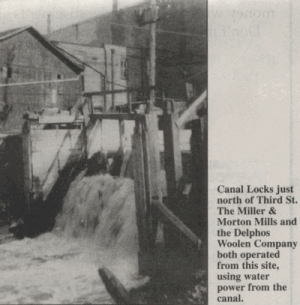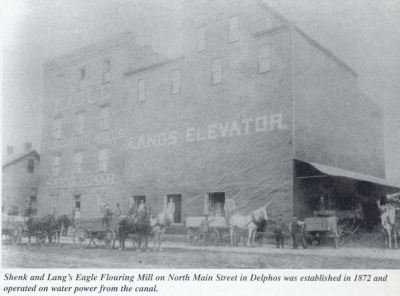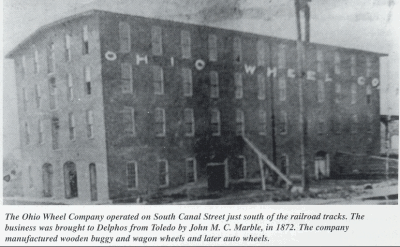
Window to the Past
Delphos Factories in the 1800s
By BOB HOLDGREVE
Located on South Canal St., just south of the railroad tracks, was the Ohio Wheel Company. One day last week we were shown through the plant of the Ohio Wheel Company, by its president, Col. J.M.C. Marble. For the last year we had seen its mammoth brick building rise until now it is four stories above the ground. At the present they have not fairly got to work in the new building, but they are employing upwards of 50 hands, and expect in a few weeks to double the number of men employed.
They receive their timber in the rough, and work it into hubs, spokes, felloes, and shafts, and in a short time expect to have the wheels ready for the tires (iron rims.) The goods are shipped to all parts of the country by the carload. We noticed particularly one little machine in course of erection that will turn out wheels for baby carriages, and we were informed, the company has an order from a single house for one hundred thousand wheels of that kind.
Their building is heated throughout by steam, not a particle of fire being allowed outside of the firemen's room. The motive power is a steam engine of 125 horse power, which not only runs the machinery, but heats all the buildings and the drying rooms.
A side track runs from the Pittsburg & Ft. Wayne track directly to the shops.
They receive large orders, even from foreign countries, with one large order going to the Sandwich Islands.
They manufacture about 500,000 second-growth hickory spokes each year; second-growth oak spokes, 50,000; forest oak spokes, 50,000; and forest hickory spokes, 1,000,000 each year. In hub timber they use about 100,000 blocks, and make about 5,000 sets of finished hubs each year. The timber used in this- immense- establishment is obtained along the line of the Miami and Erie Canal, about 25 miles south and north of Delphos.
The Union Flouring Mill is one of the largest and finest mills in the state. The building is of brick and four stories in height. It is furnished with the finest machinery in the state. The first floor is devoted to the grinding, packing, shipping, and office. There are five runs of stone of the latest improved make, with the finest French burs. The second floor is used for sinks, storage, miller's room, etc. The third floor is used for bolting, purifying and preparing middlings for regrinding into graham flour. The fourth floor-contains the separators and various other machinery, and is also used for storage.
The motive power is furnished by a Babcock & Wilcox steam engine of 75-horse power. The steam is furnished by a locomotive boiler, 15 feet long, and 5 feet in diameter.
The Delphos Union Stave Company - one of the most prosperous manufacturing plants in Delphos, if not in the state, was organized in 1869. The company has a large territory to draw on for timber and the most approved machinery to operate with. Although the factory has more than ordinary capacity for supplying customers, they are taxed to their utmost to supply the demand.
Mr. George Hall, President of the company, is a gentleman of vast experience in the business. Mr. Hall believes in putting his money "where it will do the most good" and has erected a fine brick residence, two stories, containing ten large rooms. The necessary outbuildings consist of barn, wood house, and carriage house.
In order to increase their office space, they recently erected a fine brick building, 18x34 feet in size, richly furnished in ash and walnut.
They have two cutting machines which can cut into bolts, 48 cords daily. When the roads are in good condition, from 100 to 150 cords of bolts are received daily and large shipments are made by canal, north and south.
Mr. Joseph Ostendorf holds the position of Vice President. They were located just west of the Ohio Wheel Company.
The Delphos Handle Factory was established 1872 by John and E. T. Hartwell under the name of "Hartwell Brothers."
They manufacture axe handles, neck yokes, and single-trees. They employ 23, and use a 58-horse power steam engine. Situated on lot 2, when in full blast, they make 1800 axe handles per day. They consume large quantities of hickory, most of which is obtained from along the Toledo, Delphos & Indianapolis railroad, and Miami & Erie Canal.
They are located on the west side of the canal, on the corner of Canal and West Third Street.
Stone & Stave Company
This establishment is located south of the Pittsburg & Ft. Wayne Depot, on the Miami & Erie Canal.
It has a 60-H.P. steam engine and employs 15 to 20 men. They have a capacity for cutting up 500 cords of timber each year. The timber used is white and burr oak and the staves are shipped to Cleveland and Pittsburg principally. They make stock oil barrel staves and headings. This firm is one among the manufacturing interests of Delphos which has helped to pro- mote its prosperity.
Pittsburg Keg and Barrel Company
It is one of the most extensive manufacturing establishments of Delphos.
They have a capacity for manufacturing 3,500 kegs and barrels per day, and they employ from 75 to 100. They ship all their orders to New Castle, Pa., and Terre Houte, Ind., and their orders are more than they can fill. The material used in making the barrels is elm.
Their manager is Mr. Fuller and the bookkeeper, Mr. John Humphreys.
Delphos Flouring Mills
This business is owned by Abraham Miller and P.W. Morton and was built in 1847. It is situated on the hydraulic lot on the canal north of Third St.
The size of the building was 40 feet by 60 feet and four stories high.
When Mr. Morton came to Delphos, his total capital stock was $12.50.
At the time when this mill was built, it was the first gristmill that was nearer to the residents of Van Wert County than Ft. Wayne or Piqua, except the little horse mills for grinding corn.
An amusing incident occurred shortly after the canal was built.
Two of the Gilliland brothers went to Delphos to have some grain milled. As it was necessary to stay all night, they were gathered in Hollister & Bliss store for the evening and a party of them were playing cards, with, most of the games being won by a Mr. Evans. James Gilliland, who had been looking on, remarked that he did not think that Mr. Evans won the games as much by his good playing as by the others bad playing. Mr. Evans then said he would play Mr. Gilliland three games of "old sledge," his warehouse against Mr. Gilliland's farm. Mr. Gilliland won all three games. The word spread all over the county in a short time and people would "hollar" at Mr. Gilliland and ask him if he bought grain at his warehouse.

The Paper Mill
Preparations for constructing the necessary buildings for the paper mill have commenced. The saw mill at the stone locks, a mile north of town, will be remodeled and enlarged for the new works. This will be a very desirable and valuable addition to our already extensive manufacturing enterprises.
June 7, 1877 Delphos Herald
The Paper Mill machinery is now about ready to put in motion, and manufacturing will commence on the first of August. Mr. H.P. Eysenbach has disposed of his interest to Mr. George A. Renner, of Ft. Wayne, a gentleman of large experience in the paper business. The present proprietors are Geo. S. George Renner, and Wm. Eysenbach. Wrapping, manilla and tea papers will be manufactured, and the mill will require a force of about 40 people. Three tons of straw will be consumed daily.
July 12, 1877 Delphos Herald
The Delphos Paper Mill shipped twenty-two thousand pounds of wrapping paper to a Dayton firm last week and this week received an order from the same firm for twenty-six and twenty-eight thousand pounds.
The paper manufactured by their company has already reached an enviable reputation in the markets, and the indications are that the factory will be put to its utmost capacity to meet its orders.
Jan. 3, 1878 Delphos Herald


Compiled by Robert Holdgreve
President of Delphos Historical Society
July 6, 2002 Delphos Herald Newspaper